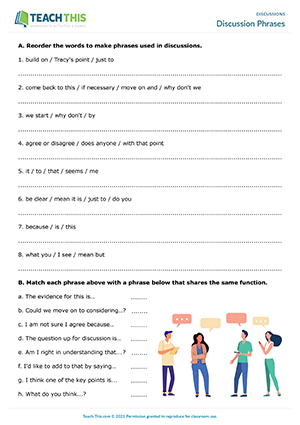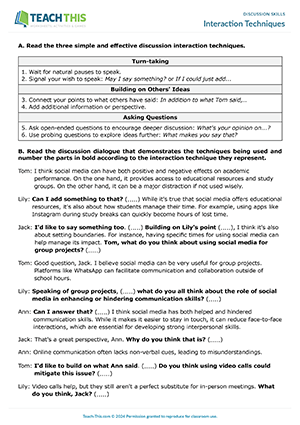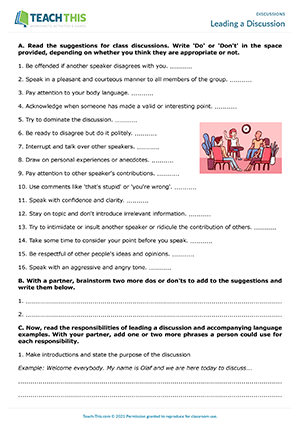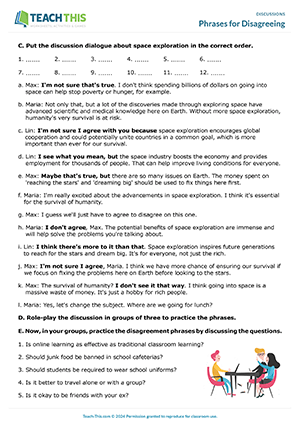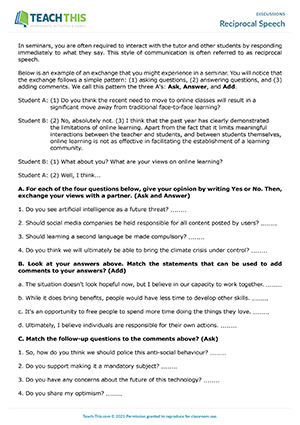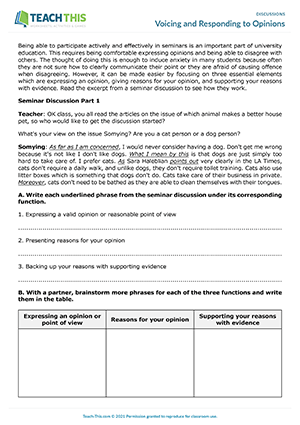In this free discussion skills speaking activity, students practice discussion expressions and then take part in rapid-fire discussions where they answer questions that ask them to choose between two things and reach an agreement within a specific time period. Students start by role-playing an example discussion with a partner. Students then read the dialogue one more time and underline ten expressions that are commonly used in discussions. Next, each pair uses the expressions to write a discussion dialogue that answers the question 'Should we visit the park or go to the museum?' After that, students take part in rapid-fire discussions with their partner where they discuss questions that ask them to choose between two things each time.
In this discussion phrases worksheet, students learn and practice phrases that are commonly used in discussions and their functions. First, students reorder words to make phrases used in discussions and match each phrase to another phrase that has the same function. After that, students match the phrases to their functions and write a new phrase for each one. Students then move on to complete gaps in a discussion with phrases from the worksheet. Finally, students practice the phrases by having a group discussion.
In this interaction techniques worksheet, students learn and practice three effective discussion interaction techniques and their associated language. First, students read about three discussion interaction techniques. Students then read a discussion dialogue that demonstrates the techniques being used and number the parts in bold according to the interaction technique they represent. After that, students complete interaction technique questions and expressions with words from a box. Finally, in groups of four, students prepare their ideas and then discuss the pros and cons of public transport using the techniques and language introduced in the worksheet.
In this comprehensive leading discussions worksheet, students learn and practice the responsibilities of and language for leading a discussion. First, students read suggestions for class discussions and label them as either 'do' or 'don't', depending on whether they think they are appropriate or not. Next, in pairs, students brainstorm two more dos or don'ts to add to the suggestions and write them down. After that, students read six responsibilities of leading discussions and accompanying language examples and add more phrases a person could use for each responsibility. In groups of three, students then discuss three topics in turn with students taking it in turn to lead the discussion.
In this expressing disagreement worksheet, students practice eight phrases for disagreeing in a discussion. Students begin by ordering words to make phrases that express disagreement. Next, students complete responses in discussions with the phrases for disagreeing. After that, students put a discussion dialogue about space exploration in the correct order. Students then role-play the discussion in groups of three to practice the phrases for disagreeing. Finally, in their groups, students discuss five questions using the disagreement phrases as much as possible.
In this informative reciprocal speech worksheet, students learn and practice discussion interaction patterns and hesitation expressions. First, students read a brief introduction to the three A's interaction pattern (ask, answer, and add) and review a model interaction. Students then read four questions and give their opinions by answering each question yes or no. Next, students look at their answers and match the statements that can be used to add comments to their answers. After that, students match follow-up questions to the comments. Students then read a list of hesitation expressions and add two more phrases of their own. Next, in pairs, students take turns responding to questions using the hesitation expressions. Finally, students practice the ask, answer and add technique and hesitation expressions by discussing four questions.
In this useful expressing opinions worksheet, students learn and practice expressing and responding to opinions in a discussion. First, students read an excerpt from a seminar discussion where someone is expressing their opinion. Next, students write each underlined phrase from the discussion under its corresponding function. In pairs, students then brainstorm more phrases for each of the three functions and write them in a table. After that, students read the second part of the seminar discussion where someone responds to the opinion. Again, students write each underlined phrase from the discussion under its corresponding function, brainstorming other phrases as before. In two groups, students then prepare an argument for or against social media use and a response to the opposing side of the argument. Finally, students pair up with someone from the other group and have a discussion on the topic of social media following the procedure given.
Latest Free
Resources
- Identifying and Clarifying Problems
Dealing with Problems (B2)
Date Added: 1st of November
- The Bus Stop
Getting Around (B1)
Date Added: 1st of October
- Study Skills Showdown
Study Skills (B2)
Date Added: 10th of September
- Everyday Objects Bingo
Everyday Objects (A1-A2)
Date Added: 25th of August
- Action Verb Races
Actions (A1-A2)
Date Added: 18th of August
Latest Member
Resources
- Editing in Action
Writing Exam Preparation (B1)
Date Added: 9th of January
- My Favourites
Likes and Dislikes (A1)
Date Added: 9th of January
- Birthday Bonanza
Birthdays (A2)
Date Added: 9th of January
- Birthday Banter
Birthdays (B1)
Date Added: 8th of January
- Where is it?
Giving Directions (A1-A2)
Date Added: 7th of January





